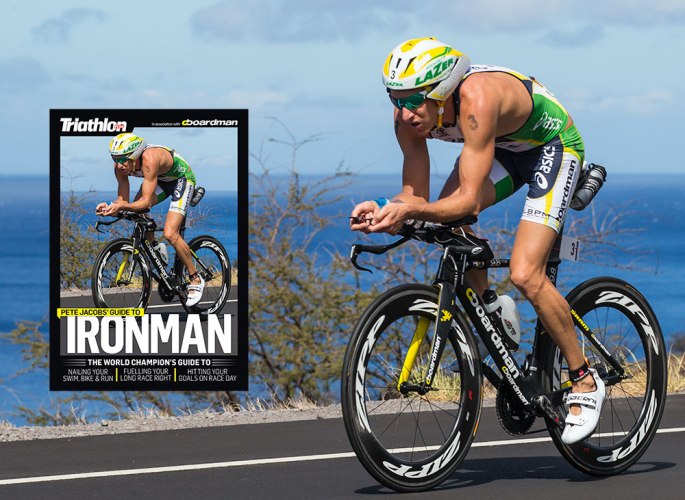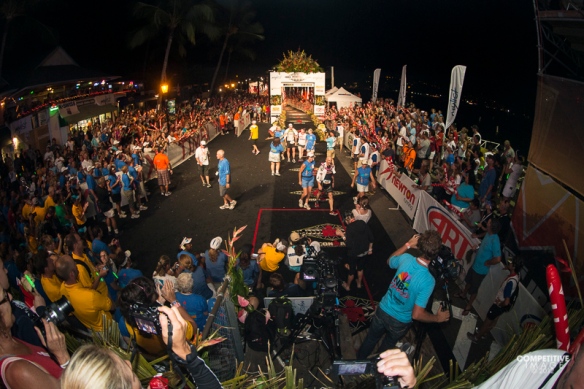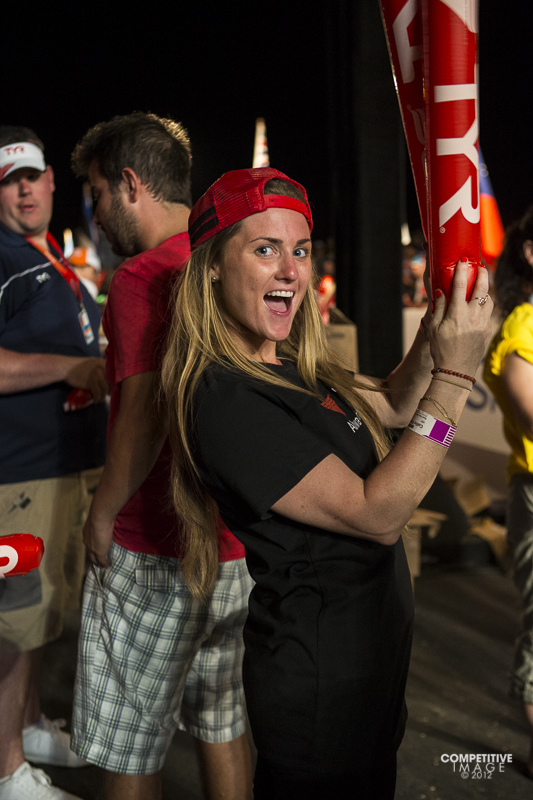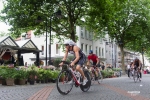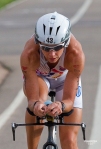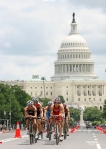In yesterday’s blog, I gave my thoughts on what are critical attributes about shooting from a motorcycle.
One thing that I mentioned in yesterday’s blog was that at Oceanside on April 2nd there were only two other motos for the media. One was for a photographer and the other for a spotter. Only having two photographers on the course is pretty rare and while there were marshals on the course, there really wasn’t much traffic for us. More common would be six or more. At the major events, sometimes they are hard to count.
Here is a common view at major events.


In the first image above, there are race marshals, still photographers, NBC videographers, and Ironman Live (streaming) videographers. The 2nd image has much the same but without NBC.
I hope this gives you a better idea of what it is really like and the driving skills required. As well as how badly things might turn out if there is someone without appropriate skills in the moving gaggle at the front of the race.
Oh yes and then there are the crowds.

The above portion of the Challenge Roth for is restricted to the TV motos and the Polizei. My driver dropped me off about 1 km from that point and to get the shots I wanted, I walked and then using a back road, he met me at the top of the hill. FYI – this image was also selected by Triathlon Business International as the Top Published Photo for 2015!
One thing I neglected to mention is that I cannot do my voodoo without a great partner. In addition, since I sit backwards, I only see the race and not really the roadway. To really have the right feel for what it is like to be out there, I have asked Bruno Desrochers, who has been my primary driver for the last 5 years to share some comments, as well as David Ashe who was a first time driver for me at the Ironman Puerto Rico 70.3 in March.
I have lost count of how many races Bruno and I have done together, but our range of events is from ITU events in San Diego, USAT Age Group Championships in Milwaukee and the 2015 Ironman 70.3 World Championships in Zell am See, Austria.
As luck would have it, we were able to find a 2015 BMW F700GS to use in Zell am See.


Here Bruno and I are just coming down out of the Alps and back into town to get ready to shoot the run. Although my preference is to sit backwards and shoot from the moto, on this course there simply was not room on the road and particularly the descents to do so. We had driven the course each of the two prior days to pick out our planned locations and to familiarize ourselves.
As we moved from spot to spot, we hit 115 km/hr and in fact dragged our foot pegs a couple of times on our BMW F700GS. I may be frowning on the outside but on the inside I am screaming, holy shit this is so much fun I can’t believe it!
The following shot of 70.3 World Champion Daniela Ryf should give you can idea of the extreme nature of the course.

Now that I hope I have sort of established the environment that we work in, my hope is that comments from Bruno and David will have greater context.
First from Bruno, although he does have a side job as an aerospace engineer, he is as close to a professional driver as I have ever met.
Bruno – I started off by volunteering for the Oceanside 70.3. The beginning of my experience with this type of driving was for race marshals. It wasn’t until the 2011 Ironman Arizona that I met Paul. I’ve read about being a moto driver in these events and spoken to professionals. Part of my motivation was by driving it provided me a way to be involved while my wife Chris was competing. Being a spectator is actually quite hard on the mind and body, especially on full Ironman events
Much of the experience is about riding with a passenger and reacting to what the passenger does. If the passenger moves a lot, this will limit how close I’m willing to get to an athlete. It is definitely more difficult to ride slowly, keeping up with a cyclist or a runner while keeping the bike stable at these speeds. Other aspects of the experience are; what’s expected from me as a rider; and what I have to do during the event – where can I go – knowing the course.
Finally, it’s about knowing the rules:
- Safety
- Don’t put you and your team in a position that will result in an accident for anyone;
- Anticipate where the others will be around you. For Age Group athletes, you have to expect the unexpected;
- Courtesy
- Let the athletes go first – don’t crowd them particularly in the turns;
- Get off the course if possible if your position is threatening to others;
- Take the time to do what you have to do, but don’t drag along. Give the space to other motos when you’re done;
- Purpose
- Know what your role is
- Abide by the rules
Anticipation is a key to safety. One time, riding downhill and keeping pace with the cyclists at about 30 mph, I was keeping a fair amount of distance all around between us and the athletes. I didn’t know what was going to happen, if anything, and even though the reaction times are the same, the time it takes for events to happen are longer, as we all know. Next thing I know the cyclist, who was about 30 meters in front of us crashed. Although surprised, I was ready and had plenty of time to swerve around without impacting those behind me. I also had time to see the poor man sliding quite a ways, but didn’t see him stop.
From my perspective, having ridden all types of motorcycles, the best is a relatively upright, not a high performance machine, easy clutch, responsive throttle, and 2-wheeled motorcycle, as opposed to a 3-wheeled Trike models. It also helps to have a short shift lever on the transmission, but obviously not necessary. A more upright position helps relieve the pressure on the wrists. Also, I often find myself slipping the clutch while maintaining slightly higher revs to maintain a really slow speed.
Finally, if a specific course was provided for this purpose, I would gladly take it. One can never have too much training and ultimately, if all moto drivers knew what to do, it would make everyone’s job so much easier and safer.
As Paul pointed out, it all starts with the motorcycle. After all, this is the tool that enables the ideal experience between the driver and the passenger. This team should be comfortable both physically and for communication purposes regardless of the passenger’s job. In addition, the moto is there because of the event, so having a loud motorcycle is not a good feature. The reason is twofold; the first being that if the passenger is a marshal, there’s no point in advertising to the cyclists that the marshal is coming up being them; the second is that even if the passenger is not a marshal, there’s no point in freaking out the cyclist when riding by at greater speeds. So considering that these events are usually half-Ironman or Ironman distances, the moto team will be there for a long time.
I’ve had the opportunity of riding for marshals and photographers. Often times, I have seen volunteer marshals that have had little to no experience on a motorcycle or even as a marshal. I think it’s obvious that this is not advisable. Personally, I am perfectly happy to teach a person on how to ride behind a motorcycle, but doing so at an event is not the place to do so. In this case, the passenger could misinterpret what they were told, and do something inadvertent that could lead to an potentially tragic accident. I’ve also seen an inexperienced person climb onto a motorcycle only to end up on the ground, along with the motorcycle and the rider. However, as these events require volunteers, you don’t get to pick and choose the rider/moto or the marshal.
I agree with Paul’s statement that the moto driver is responsible for the safety of the crew and everyone around it. Having Paul ride backwards is actually a boon as he becomes my eyes-in-the-back-of-my-head, and since we communicate through an intercom system, he can advise me of the status from his perspective. This results in an increase in safety. But the reason I’m there is to help Paul get the perfect shot. Yes, safety is number one! So I will evaluate Paul’s requests and if I can do it, I will. And since we’ve known each other, Paul has acquired his ideal motorcycle for these events and we’ve modified it a lot to help his effort. After all, this is basically his desk while at work.
One point I would like to make. I see the volunteer marshals/spotters, who are often athletes themselves, come to these events. I applaud these folks since without volunteers, there likely will not be an event, and it’s a way to give back to their sport. However, these volunteers should be made aware that dressing appropriately for motorcycle riding is preferable. I’ve seen folks in T-shirt, shorts and sandals. I know that it can be hot at times, but having at least a pair of jeans and a decent jacket with shoes could mean the difference between a road rash and a serious injury. I personally have lost many pounds in water as a result of the gear I wear. Loose/floppy clothing is not a good idea. It is always best to bring your own helmet, a small investment in the most secure and safest fit.
Having experience with both marshals and photographers, I prefer photographers. The simple reason is that the photographer usually wants to shoot as many of the athletes as possible, so we’re not limited to observing a few of them, and you get to see more of the action. Of course, they are usually more experienced passengers, so they are more likely to know what to do and what is expected of them on a motorcycle. I remember driving for Andrew Loehman at Lake Tahoe who liked to stand on the pegs while taking pictures. It wasn’t until the third or fourth time that I realized what he was doing. Although I would have preferred him telling me, he was so well balanced that I just didn’t know he was standing up.
We can be riding along with the pros and are just as likely to see age-groupers, especially on the run. One should note that there are no marshals on motos during the run, but with the right photographer, it is possible to ride with the runners. I must admit though that this is usually the most stressful time of the day. Some photographers like to stop more often and take pictures from different vantage points, which could also be interesting. All in all, for me, this is the best seat in the house.… and I usually get to see my wife somewhere along the way and encourage her, woohoo!
Paul – Thanks to the expansive world of Social Media, I was able to connect with David through the Facebook page for the BMW Club of Puerto Rico. Not unlike Bruno, David has a side job. He is a Private Equity investor, and is currently running one of his portfolio companies in the specialty consumer finance arena.

Remember the moto reserved for the media that I mentioned in yesterday’s blog – the BMW S1000RR? Here is David on his double R, doing what it is made to do.

David – I have been riding motorcycles since I was ten years old, but I have been a motorcycle fanatic since much younger than that. My first tricycle as a toddler was a just a stand-in for the real thing; I just added the engine noises myself. Many years ago, I caught a glimpse of the Tour de France coverage while surfing TV channels. What caught my eye were not the alpine views and the superhuman fitness of the riders, it was the motorcycles. Dozens of motorcycles, carrying photographers and also support crews for the teams, sometimes with several bicycle wheels on hand, weaving in an out of the crowds and the athletes, speeding up to catch the next “peloton”, or stopping to get a shot, or aid a competitor. Now, that looked like a lot of fun, I wondered who these people were, and marveled at their control of their large (mostly) BMW motorcycles, at slow and high speeds, and almost always at close quarters.
So it was a welcome surprise when Paul found me in our local BMW Club Facebook page, and inquired about finding volunteers to serve as his “moto” during the Ironman Puerto Rico 70.3 triathlon. Since my current ride is a BMW S1000RR sport bike (not at all suited to riding with passengers, much less as a photo moto), I cast a net to try to find him a rider with a BMW R1200GS, perhaps the best platform for this purpose. Well, I got caught up in the net, though I didn’t put up much of a struggle. At the end of the day, our local dealer offered up one of their demo bikes, so long as I was the rider.
It was a ton of fun. Most motorcycles with ample passenger seating will do just fine; even one of those large scooters will probably work. As it happened, the R1200GS was a great mount, combining low-speed maneuverability with the power to quickly get in position, to quickly cover ground when needed, and with the brakes to haul two large adults to quick, safe stops when needed. Since part of the time Paul was sitting facing backwards, the rear top case (the side cases will just get in the way and are not needed) was a bonus, allowing him to rest his elbows on it and also giving him additional protection when accelerating hard. And accelerate hard we did, allowing him to get shots of the rear and middle packs of bicycle riders and then speeding off to get to the leaders. This required bursts of speed, at one time reaching 100 mph on the gratefully closed roads, no sweat for the big boxer twin. After chasing down the lead bicycle riders, we then transitioned to the running section, which required some slow-speed riding in tight quarters. This time, the big GS tiptoed her way through the event like the all-around champ that she is.

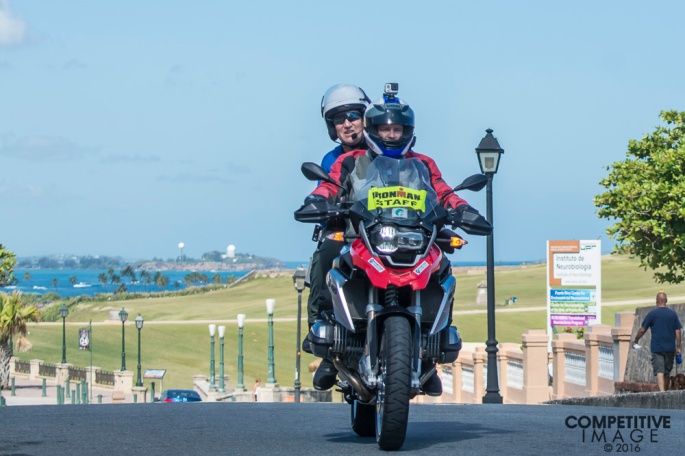
Do not try this if you are not experienced in carrying passengers your own size and weight, and who will be moving around on the back seat. In fact, this is a job for very experienced riders, as we had to accelerate, brake, and turn, under conditions that might have been taxing to riders with lesser skills. But the real key to a safe and fun day is the quality and quantity of communication between pilot and photographer. It helped greatly that Paul connected his Sena bluetooth communicator to my helmet, and this allowed us to coordinate every move much better than through shouting, tapping, or however else we would have had to manage. In addition, Paul made it very clear that every decision regarding driving the motorcycle would be up to me, and only me. If he said “go”, and I didn’t think it would be safe, we didn’t have to go, even if it meant missing a shot. We also met the day before, went over the route, practiced with Paul sitting backwards and reviewed the plan for the day, which started at 5:00 AM. Having clear expectations up front, and not feeling any pressure to perform made it fun, and safe.
I strongly recommend pitching in and acting as a “photo moto pilot” in an Ironman, or similar event. You will get a chance to be a part of a fun event (without having to swim/bike/run for 70.3 miles!), and feel the electricity generated by these large gatherings of like-minded people. It’s yet another riding experience, and one I look forward to repeating sometime soon.
Paul – In conclusion, I hope yesterday’s blog and this one will provide some insight as to the requisite skills, equipment and safety measures that are necessary on the course, and what the media and drivers deal with.
One final photo, it really doesn’t have anything to do with the blog but it is a shot of me riding my BMW F800R and loving it!

Zalusky Advance Rider School – Thanks Tina Kelly for the snap
More soon – See you at the races!










